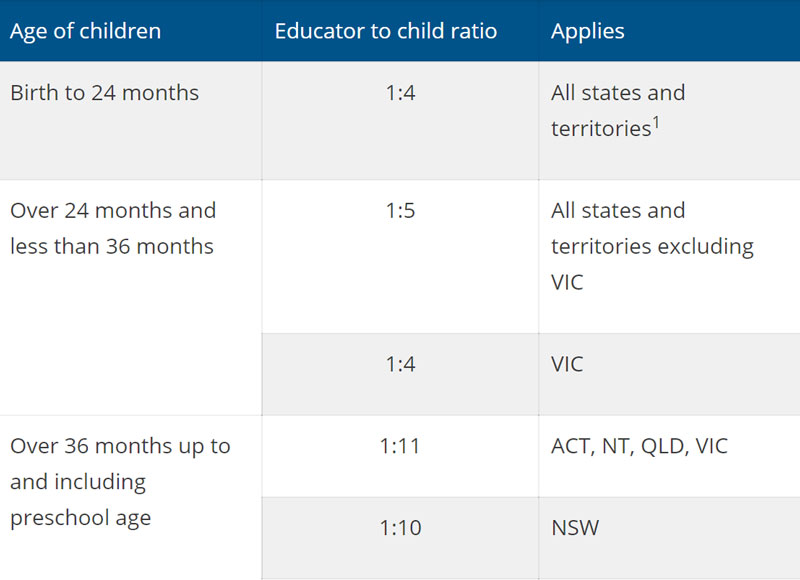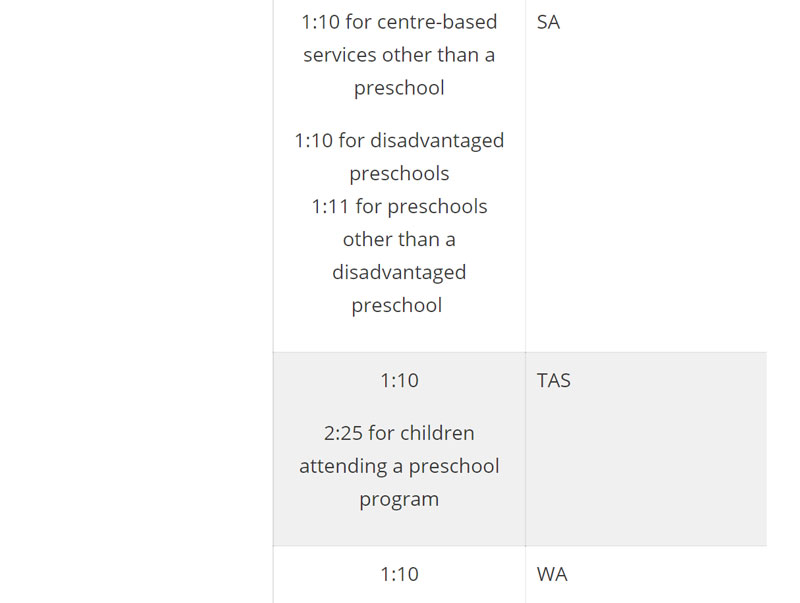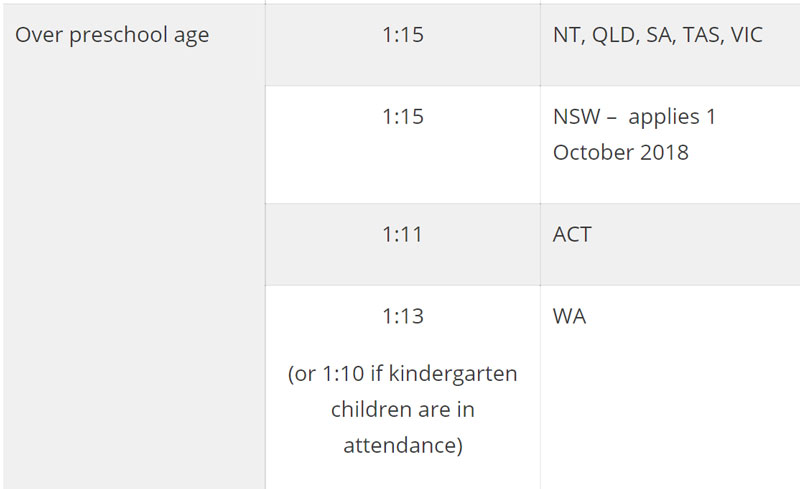Minimum educator-to-child ratios and purposeful for services to highlight the importance of the safety, welfare and wellbeing of children and for Educators to effectively supervise children within the environment.
The Education and Care Services National Regulation sets out the minimum educator to child ratio requirements services must adhere to while caring for children. Educators must be working directly with children to be counted in the educator to child ratios.
According to the Education and Care Services National Regulations, the educator and child ratios are as follows:
Family Day Care Ratio Requirements
- (1) A family day care educator must not educate and care for more than 7 children at a family day care residence or approved family day care venue at any one time.
- (2) In determining the number of children who can be educated and cared for by a family day care educator for the purposes of sub-regulation (1)—
(a) no more than 4 can be preschool age or under; and
(b) if the children are being educated and cared for at a residence, the educator’s own children and any other children at the residence are to be taken into account if—
(i) those children are under 13 years of age; and
(ii) there is no other adult present and caring for the children.
- (3) No more than 7 children can be educated and cared for as part of a family day care service at a family day care residence or an approved family day care venue at any one time.
- (4) Subregulation (3) does not apply to children visiting a family day care residence or an approved family day care venue as part of an excursion.
Note. A visiting family day care educator must do a risk assessment for the excursion under regulation 100.
- (5) Despite subregulations (1) to (4), the approved provider of a family day care service may approve, in writing, a family day care educator to educate and care for more than 7 children, or more than 4 children who are preschool age or under, at any one time, in exceptional circumstances.
- (6) For the purposes of subregulation (5), exceptional circumstances exist if—
(a) all the children being educated and cared for by the family day care educator are siblings in the same family; or
(b) a child to be educated and cared for is determined to be in need of protection under a child protection law and the family day care educator is determined to be the best person to educate and care for the child; or
(c) the family day care residence or approved family day care venue is in a rural or remote area and no alternative education and care service is available.
Centre Based Ratio Requirements
Minimum educator to child ratios in centre-based services (regulation 123) are calculated across the whole service, not by individual rooms. To be clear:
- The number of educators required is calculated based on all children in attendance at the service regardless of grouping or room configuration.
- In a mixed age group of children, an educator who is caring for one age range of children can also be counted against another age range of children, as long as the ratio for each age range is maintained and adequate supervision is maintained at all times.
- The first step is to determine the number of educators needed for the youngest age range of children in the group. Once that ratio is met, an educator can also supervise children in another age range, provided the youngest age range is still maintained.
- Maintaining the ratio for each age range of children in the mixed age group does not mean the educator to child ratio for the youngest age range must be applied to all children in an older age range.
By applying minimum educator to child ratios across the entire service, centre-based services can flexibly arrange educators in a way that effectively responds to the needs of all children.
The ratio requirements across all age ranges in Australia are as follows:

Ratios are calculated using whole numbers of educators. When you are calculating the number of educators required across your service you must round up.
- For example, if you have 7 children who are 18 months of age, the required educator to child ratio is 1:4, therefore if you divide the number of children by 4, your answer would be 1.75 educators required. Since you are unable to have .75 of an educator, you round up and two educators are required. Similarly, if you have 5 children aged 18 months, you are also required to have two educators, as you cannot have .25 of an educator.
- Whole numbers are also used to decide how many qualified educators are required. The National Regulations set qualification requirements for educators at centre-based services. Regulation 126(1)(a) stipulates that ‘at least 50 per cent of the educators who are required to meet the relevant educator to child ratios for the service must have, or be actively working towards, at least an approved diploma level education and care qualification’.
- Rounding up also applies to calculate how many educators must be qualified. For example, if your service must have 13 educators, 50% of these educators equates to 6.5 educators. As you cannot have .5 of an educator, you must round up to 7. Having 7 qualified educators satisfies regulation 126(1)(a) as 7 is ‘at least 50%’, whereas rounding down and having 6 qualified educators would be less than 50% and therefore not comply with the National Regulations.
To be included in the educator to child ratio, educators must be working directly with children (regulation 122), meaning that educators are physically present with the children and directly engaged in providing education and care to the children (regulation 13).
- The National Regulations require educator to child ratios to be maintained at all times when an education and care service is operating, regardless of the activity children or educators at the service are undertaking.
- Educators should be replaced when not working directly with children (e.g. when on a scheduled lunch break or undertaking administrative tasks), however, some jurisdictions have specific provisions which modify these ratio requirements when educators are taking short breaks and are not working directly with children.
- Service providers should check if jurisdiction-specific regulations or guidance apply in their state or territory and contact their regulatory authority for advice if required.
Meeting Educator to Child Ratios
Some services may need to increase the number of qualified educators in order to meet the new ratio requirements. To, be included in ratios, educators need to meet the appropriate qualification requirements, which may also include “actively working towards an approved qualification”.
This means that an educator doesn't necessarily have to have a completed qualification if they are meeting the requirements set below they too can be part of the ratio.
Cert 3 Qualified Educator: An educator can be counted as a cert 3 qualified educator is they hold an approved qualification or if they are “actively working towards” the following requirements:
- Being enrolled in a course for the qualification
- Commenced the course
- Making satisfactory progress towards completion
- Meeting requirements to maintain enrolment
Diploma Qualified Educator: An educator can be counted as a diploma qualified educator if they hold an approved diploma qualification or if they are “actively working towards” the following requirements:
- Being enrolled in a course for the qualification
- Commenced the course
- Making satisfactory progress towards completion
- Meeting requirements to maintain enrolment
- Hold an approved cert 3 qualification OR
- Have completed the approved cert 3 units OR
- Have completed 30% of the unit in an approved ECT qualifications
ECT Qualified Educator:
In June 2019, the Education Council agreed to extend regulation 242 of the National Regulations. Under regulation 242, you are ‘taken to be an early childhood teacher’ if you:
- Are enrolled in an approved early childhood teaching qualification, and
- Give the approved provider documentary evidence from the course provider that you:
- Have started the course, and
- Are making satisfactory progress towards completing the course, and
- Are meeting the requirements for maintaining the enrolment, and
- Hold an approved diploma level educator qualification, or have completed at least 50 per cent of the course.
Regulation 242 does not apply in Victoria or if you are working in a centre-based service educating and caring for 30 or more children preschool age or under in NSW.
Regulation 242 is scheduled to expire in the ACT, NSW, Queensland, South Australia and Tasmania on 31 December 2021.
Regulation 242 is scheduled to expire in the Northern Territory and Western Australia on 31 December 2023.
Once regulation 242 expires, an educator will need to have completed their ECT qualification to be considered a qualified ECT. However, educators ‘actively working towards’ an approved ECT qualification may still be counted as a certificate III or diploma level educator, depending on how much of the approved ECT qualification they have completed.
‘Actively working towards’ provisions may not apply where a state or territory-specific regulation is in place, including for services educating and caring for school-age children. If you have any questions about this, contact your regulatory authority.
Please note that all family day care coordinators in Australia are required to have an approved diploma level education and care qualification and cannot be ‘actively working towards’ this qualification.
All children being educated and cared for by an education and care service must be adequately supervised at all times while in the care of the service (section 165).
Reference:
Educator to Child Ratios, ACECQA
Ratios For Centre Based Services - Refresher, ACECQA
Actively Working Towards A Qualification, ACECQA
Education and Care Services National Regulation, NSW Legislation, NSW Government









 As an Educator in Australia, your pay rate falls under the Children’s Services Award 2010. This award states the minimum amount that an employer can
As an Educator in Australia, your pay rate falls under the Children’s Services Award 2010. This award states the minimum amount that an employer can When working as a qualified Early Childhood Teacher (with a university degree) within a service, your rate of pay will come from the Educational Services
When working as a qualified Early Childhood Teacher (with a university degree) within a service, your rate of pay will come from the Educational Services When working as a Diploma Qualified Educator your pay rate is from the Children's Services Award 2010. This Award states your minimum rate of pay
When working as a Diploma Qualified Educator your pay rate is from the Children's Services Award 2010. This Award states your minimum rate of pay When working as a Cert 3 Qualified Educator, your pay rate is from the Children's Services Award 2010. This Award states your minimum rate of
When working as a Cert 3 Qualified Educator, your pay rate is from the Children's Services Award 2010. This Award states your minimum rate of Educational Leaders play a crucial role in their early childhood service by ensuring that the educational program aligns with best practices and supports the holistic
Educational Leaders play a crucial role in their early childhood service by ensuring that the educational program aligns with best practices and supports the holistic In early childhood education and care, ratios are more than a technicality—they are a frontline safeguard. Every child deserves responsive supervision, emotional connection, and developmental
In early childhood education and care, ratios are more than a technicality—they are a frontline safeguard. Every child deserves responsive supervision, emotional connection, and developmental With the new national child safety reforms kicking in on 1 September 2025, early childhood services like yours have a real opportunity to lead the
With the new national child safety reforms kicking in on 1 September 2025, early childhood services like yours have a real opportunity to lead the Here’s a comprehensive Mobile Phone and Smart Watch Policy tailored for early childhood education and care (ECEC) services in Australia, aligned with the latest 2025
Here’s a comprehensive Mobile Phone and Smart Watch Policy tailored for early childhood education and care (ECEC) services in Australia, aligned with the latest 2025 The Sea of Fish Challenge is a national initiative that invites children, educators, families, and communities to create and display fish artworks as a symbol
The Sea of Fish Challenge is a national initiative that invites children, educators, families, and communities to create and display fish artworks as a symbol Cold weather play is incredibly beneficial for early childhood development! It helps children build resilience, strengthen their immune systems, and develop essential motor skills. Here’s
Cold weather play is incredibly beneficial for early childhood development! It helps children build resilience, strengthen their immune systems, and develop essential motor skills. Here’s


